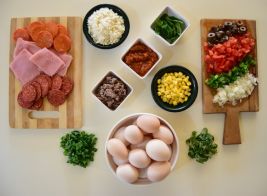
Do your students ever appear to be unorganized in the kitchen? Do they lack time management skills because they are uncertain as to what to do? Do they ever act as though they’ve never read a recipe or set foot in a kitchen? If any or all of the above sound familiar, then this Mise en Place Lesson may be helpful in getting students more organized so they can manage time more effectively and become more confident in the kitchen!
Set
- Introduce the topic by playing the “Put a Finger Down” game using the following questions (note: use them all or pick and choose):
- Put a finger down if you’ve ever forgotten an ingredient in a recipe.
- Put a finger down if you generally don’t read a recipe all the way through ahead of time.
- Put a finger down if you ever didn’t understand a term or direction within a recipe.
- Put a finger down if you don’t clean-up as you cook/prepare food.
- Put a finger down if you are an unorganized, messy cook/chef.
- Put a finger down if you are unfamiliar with the term mise en place.
- Put a finger down if you never made a recipe from scratch/homemade.
- Put a finger down if you’ve had a recipe fail.
- Put a finger down if you have never cooked food on a stove or in an oven.
- Put a finger down if you’ve gotten part way through a recipe and realized you don’t have a specific ingredient.
- Put a finger down if you’ve ever measured an ingredient incorrectly.
- Put a finger down if you’ve ever added more or less of an ingredient.
- Put a finger down if the only way you know how to prepare food is via a microwave.
- Put a finger down if you’ve ever added ingredients to a recipe out of order.
- Put a finger down if you’ve ever forgotten to preheat the oven.
- Put a finger down if you’ve ever left a mess in the kitchen for someone else to clean up.
- Put a finger down if you’ve ever used a tool or appliance incorrectly.
- Put a finger down if you’ve ever gotten frustrated while trying to cook/bake.
- Put a finger down if you’ve ever walked away from preparing a food before it was finished and threw it away.
- Put a finger down if you’ve ever started to prepare a food and then handed it off to someone else to finish.
- Put a finger down if you ever wanted/needed to ask a question, but didn’t because you were afraid of how it might look.
- Put a finger down if you ever didn’t understand a cooking method or process in a recipe.
- Put a finger down if you’ve ever rushed through a recipe just to get it done.
- Discuss the connections between all of the prompts. Explain that you are not trying to make them feel bad, but understand the importance of reading, organizing, understanding and following a recipe in a lab where time is limited so you can be successful.
- Intro mise en place by individually or as a class showing this video titled “What is Mise en Place?” and having them answer the following questions using the video guidesheet (see below):
- What is the translation of “mise en place”?
- Where does the term originate?
- Why is “mise en place” in cooking or baking so important and what are the 3 main benefits?
- Describe what is included in a mise en place.
- List the 5 basic steps of “mise en place”
- Share and discuss answers to be sure students understand the concept.
Materials
- iPad & Laptop
- Projector & Screen
Activities
- If you are carrying this lesson over to the next day, be sure to begin with a bell-ringer review. If you follow a block schedule, simply continue the lesson.
- Assign students the Mise en Place Circle Story (see below) using the recipe for Shrimp Rice Creole for practice. This was designed around the video mentioned above. Note: The same template can be used with any recipe you plan to make in the lab and can be a pre-lab assignment to be sure students have read the recipe, before assigning actual jobs to students.
- While you may think this activity is redundant, studies show that the more students work with the information, the more they understand! So, if they are reading the recipe to complete the template and then again to assign lab jobs they should be more familiar with the recipe (and hopefully successful) by the time they actually prepare it in the lab.
- I’ve included a sample of what this should look like for the Shrimp Rice Creole recipe.

